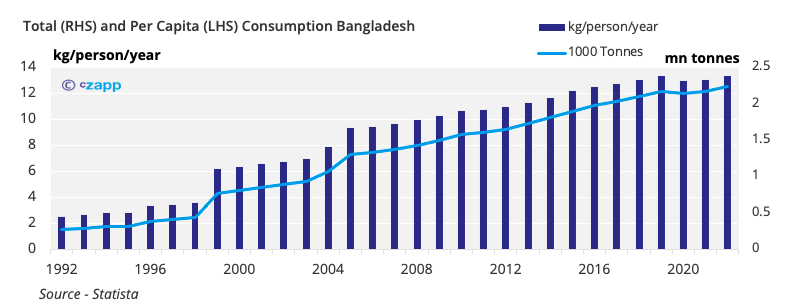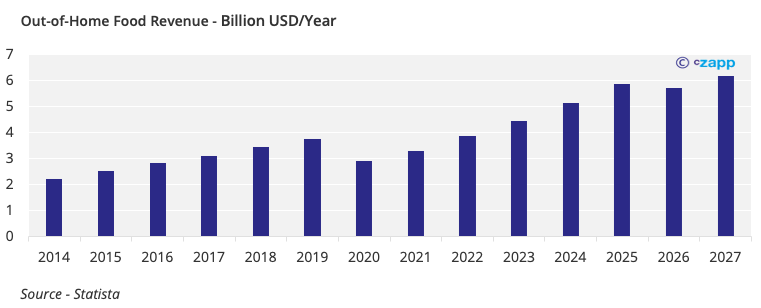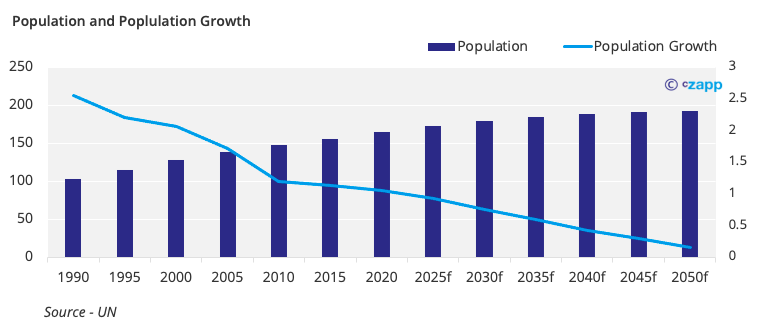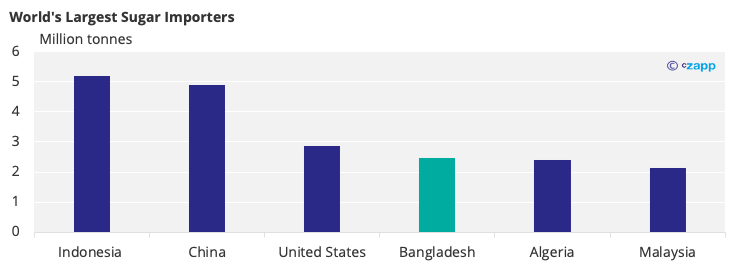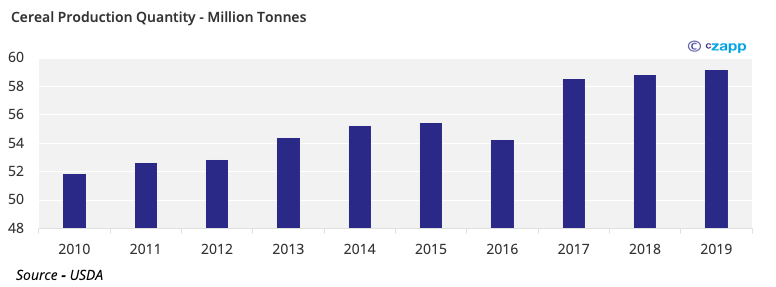Bangladesh’s Growing Sugar Demand Adds to Need for Production Investment
Albert MacKenzie
Insight Focus
- Economic development, growing population boosting demand in Bangladesh.
- Consumption will push higher still as Bangladesh’s economy continues to boom.
- Bangladesh’s increasing imports are likely to put more focus on stagnant production growth globally.
Sugar consumption in Bangladesh is eight times higher than it was just 20 years ago. Massive economic and population expansion have driven this rise. It looks likely that the growth will continue in the coming years. As consumption grows Bangladesh’s significance as an importer will increase substantially. Global consumption continues to grow, but as production remains stagnant the need for investment increases.
Sugar Demand Increases in Bangladesh
Bangladesh is fast becoming one of the world’s biggest consumers of sugar and, for several reasons, this trend looks set to continue for years to come.
Bangladesh is becoming an increasingly urbanised society. As a result, demand for convenience foods, snacks and confectionary, which are high in sugar is on the rise. This trend marks Bangladesh’s divergence from a more subsistence focused diet, which focused on rice and seafood.
Spending on confectionary and snacks more than doubled between 2014 and 2021 on both a total and per capita basis. Across the board more money is being spent on food in Bangladesh.
In recent years there has also been a massive increase in revenue for out-of-home food consumption. This is raises sugar consumption as restaurant, take away, and street foods tends to have higher amounts of sugar than food made at home.
The huge change in consumption patterns is largely being driven by rapid economic development. In a little over ten years Bangladesh’s GDP per capita has grown from roughly half of India’s to now exceeding it. Since 2007 Bangladesh’s GDP and GDP per capita have grown 305% and 251% respectively.
This massive increase in economic power has meant that consumers have far more disposable income and thus there is increased expenditure on higher sugar foods, as well as food more broadly.
Population growth is also a huge driving factor. The double push of increased population and increased per capita consumption has contributed to the dramatic rise in sugar consumption.
Is Consumption Set to Grow?
Population growth, one of the largest drivers of growth, is set to continue for several years. This will lead to 14 million new consumers over the next 10 years. Population growth, however, is slowing. Bangladesh’s population is predicted to peak around 2050 and growth will likely slow from now till then. This means that although population growth will stoke consumption growth it will do so more slowly going forward.
Economic growth, however, paints a different picture. HSBC predicts that Bangladesh will have the fastest growing economy in the world up to 2030, with a 7% a year growth rate over 2023-28. This will increase to 7.2% between 2028 and 2033. Increased purchasing power will likely push up demand for sugary foods, reinforcing the existing trend.
The dual factors of a growing population and with increased purchasing power will continue to make Bangladesh a major sugar consumer.
Urbanisation is also likely to continue to drive consumption. The rate of urbanisation is set to diminish slightly over coming years but remain strong. The percentage of population living in urban areas is likely to increase by roughly a quarter in the coming decade. This will in turn increase access to high sugar foods and boost their consumption.
Imports Needed to Meet Demand
Due to its growing consumption and lack of production capacity Bangladesh has emerged as a key importer of sugar.
Sugar production in Bangladesh consistently contributes to less than 5% of domestic needs. Not only is domestic production low but it is also declining.
Bangladesh is one of the most densely populated places on earth, leading to a decline in agrarian jobs and an increase in the manufacturing sector to sustain the growing economy.
Due to Bangladesh’s potentially precarious food situation, sugar production takes a back seat to cereals that are considered more crucial to food security than sugar. This is especially true considering the Russian invasion of Ukraine, which has
highlighted food security issues in developing countries.
Quality is also an issue. Bangladesh’s domestic sugar supply is mainly used as “table sugar” rather than by food and beverage companies in soft drinks due to outdated production techniques which result in low quality. As Bangladesh becomes wealthier and soft drink and snack consumption plays a larger role in overall sugar consumption, this is likely to become even more pronounced.
All this points towards growth in sugar imports by Bangladesh.
Bangladesh’s Reliance on India May Become a Problem
In recent years Indian sugar has played a major role in Bangladesh’s imports. This too prompts interesting questions.
India’s sugar exports and production may be peaking and it may become an unreliable source of imports due to increased ethanol diversion and other factors.
Bangladesh overwhelmingly imports raws which tend to come from Brazil, Australia, Thailand, and India. Refineries in Bangladesh aren’t currently operating at maximum capacity, meaning they will probably be able to absorb increased imports.
It is likely therefore that Bangladesh will look to Brazil to satisfy its demand in coming years, as it did before 2019. If this prediction proves accurate Bangladesh will soon be taking about 10% of Brazil’s exports. This increased demand may put more pressure on Brazilian mills to prioritise sugar over ethanol. With freight substantially higher than it was a few years ago Bangladesh may consider sources closer by.
As covered in
our series late last year, global production isn’t growing along with populations and demand, so an increase in Bangladeshi imports is likely to make that situation even more acute
Bangladesh’s increasing demand reinforces the point we made earlier in the year, populations and economies are growing globally and as a result consumption is too. Production, however, remains stagnant, therefore more investment is needed to meet future demand.
Concluding Thoughts
- Massive changes in Bangladesh’s socioeconomic situation in recent years are driving up sugar consumption.
- These factors will continue to drive Bangladeshi demand trends.
- But Bangladesh is extremely reliant on sugar imports due to low production capacity.
- Now, with food security coming into focus, authorities are likely to focus more on grains production than sugar.
- Bangladesh is already the world’s fourth largest sugar importer and it is likely to become even more significant in the coming years.
- Brazil could take some market share in Bangladesh as India focuses on ethanol production.
Another report
<p>Bangladesh Sugar Market industry report focuses on the current market size, share, trends, and growth. CAGR of 2.43%, Market Size: US$2,376.338 million in 2029.</p>

www.knowledge-sourcing.com
The Bangladesh sugar market is expected to grow at a compound annual growth rate of 2.14% over the forecast period to reach a market size of US$2,290.008 million in 2027 from US$1,974.828 million in 2020.
Market Overview:
Bangladesh's economy depends heavily on the sugar industry for jobs and agricultural support. There are 15 (fifteen) sugar mills in the nation, one distillery plant that uses molasses, and one engineering unit. Bangladesh Sugar and Food Industries Corporation (BSFIC), which is under the administrative control of the Ministry of Industries, owns and manages 19095.15 acres of the total land area (Source: bsfic.portal.gov). In addition to producing sugar, sugar mills also produce other byproducts such as bagasse, molasses, and wasted wash. Bagasse is used in boilers to generate heat, molasses is used in distilleries to create alcohol, and wasted wash is used to create organic fertilizer. The cultivation of sugar cane uses this organic fertilizer.
Growth factors:
Growing sugar demand due to a shift in consumption
Eight times more sugar is consumed in Bangladesh now than there was just 20 years ago (2,768,000 metric tons in the year 2021). Large-scale economic and demographic growth are to blame for this increase. In the upcoming years, it appears likely that the growth will continue. Bangladesh will become a far more important importer as the market expands. Despite rising global demand, stagnant production means that more investment is required. The enormous shift in consumption habits is mostly the result of quick economic growth. (Source: apps.fas.usda.gov)
Low gas supply for refining
In the first week of October 2022, the government of Bangladesh increased the price of sugar in an apparent effort to keep up with the market because traders were already selling it for more than the previously set pricing. 90–95% of imported sugar, according to data from the National Board of Revenue (NBR), is unrefined. Due to a reduction in the availability of gas to refining facilities, the production of sugar has fallen dramatically. (Source: thedailystar.net)
Key Developments:
- September 2022: The government of Bangladesh as per instructions of the prime minister is working to raise domestic output while lowering imports as the country's sugar industry is expected to recover soon. They are creating novel, high-yielding sugarcane cultivars and offering producers technological assistance. They have also raised the price of sugarcane and provided other incentives to persuade farmers to grow the crop.
- October 2022: The country's first sugar mill, Deshbandhu Sugar Mills Ltd, which began operations in 1932 and was privatized in 1999, plans to go public for an estimated capital of Tk100 crore to finance a 50% increase in capacity before 2024. Their current daily capacity for refining sugar at Narsingdi is 1,000 tons, and the expansion project will increase that capacity to 1,500 tons during the next 12 to 15 months. (Source: tbsnews.net)
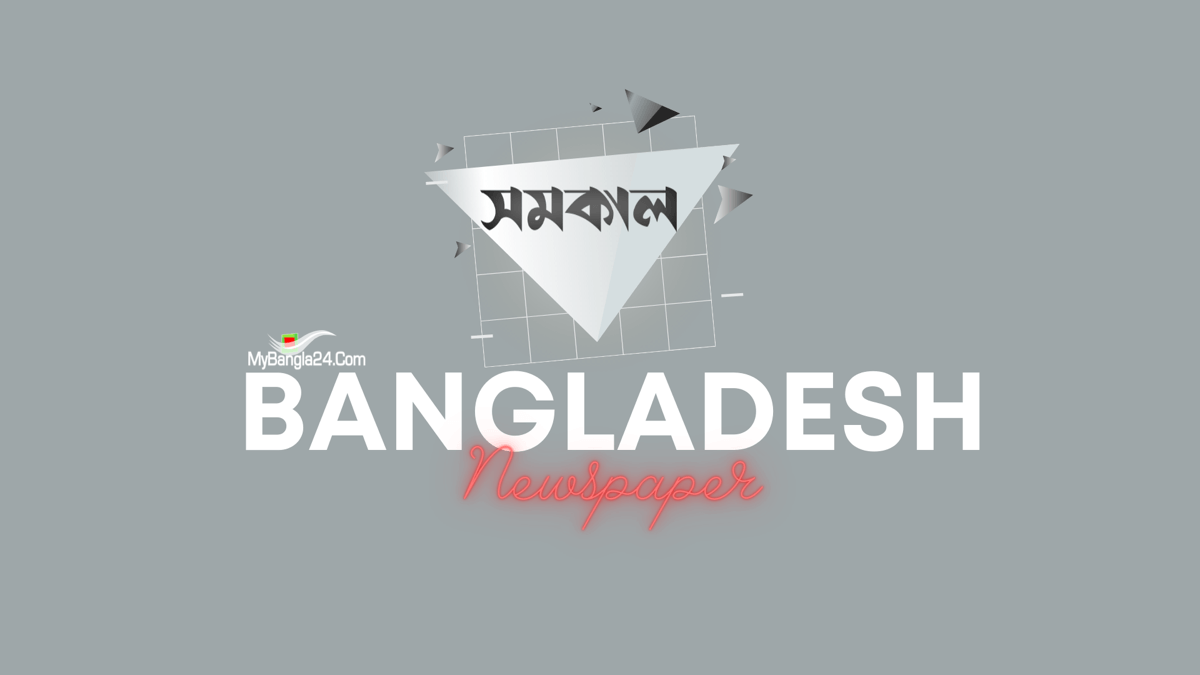
 mybangla24.com
mybangla24.com





